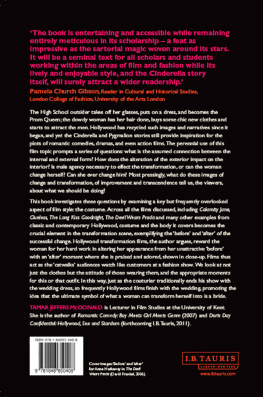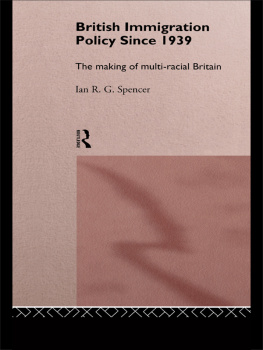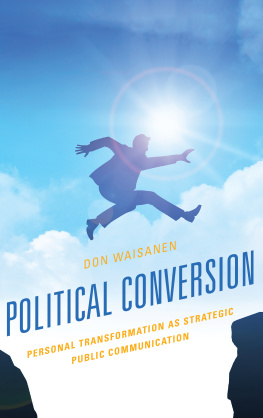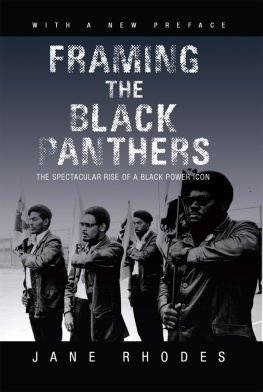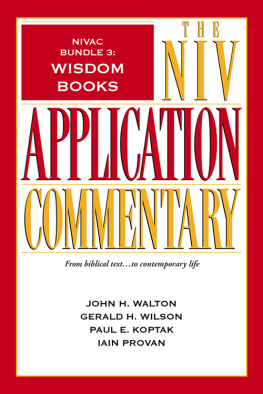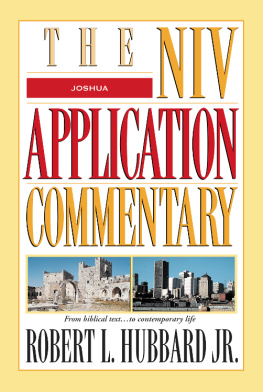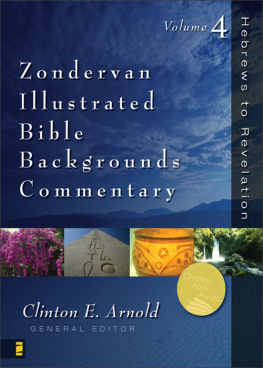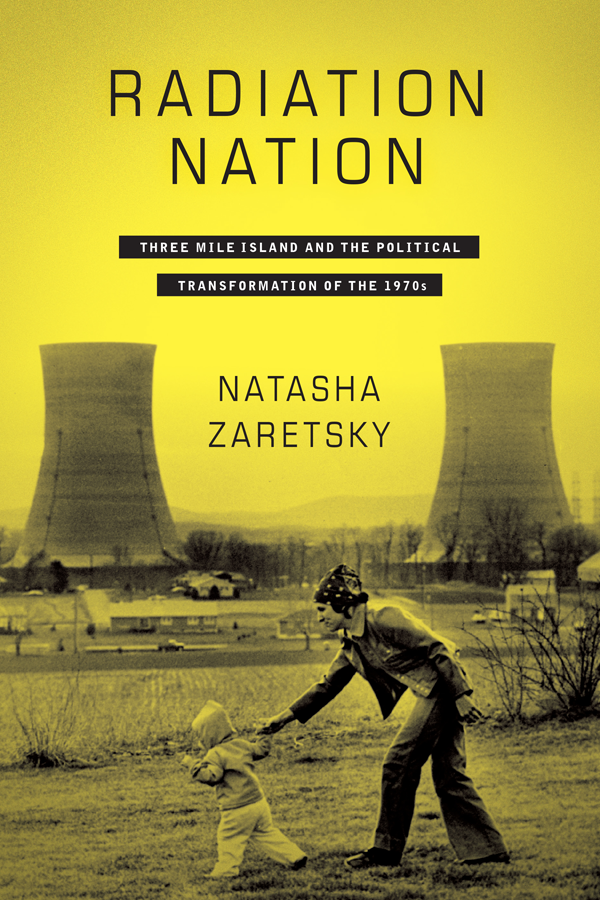Contents
Guide
Pagebreaks of the print version
RADIATION NATION
Radiation Nation
THREE MILE ISLAND AND THE POLITICAL TRANSFORMATION OF THE 1970s
Natasha Zaretsky

Columbia University Press
New York
Columbia University Press
Publishers Since 1893
New York Chichester, West Sussex
cup.columbia.edu
Copyright 2018 Columbia University Press
All rights reserved
E-ISBN 978-0-231-54248-7
Library of Congress Cataloging-in-Publication Data
Names: Zaretsky, Natasha, 1970 author.
Title: Radiation nation: Three Mile Island and the political transformation of the 1970s / Natasha Zaretsky.
Other titles: Three Mile Island and the political transformation of the 1970s
Description: New York: Columbia University Press, [2018] | Includes bibliographical references and index.
Identifiers: LCCN 2017038412 | ISBN 9780231179812 (pbk.: alk. paper) | ISBN 9780231179805 (cloth: alk. paper)
Subjects: LCSH: United StatesPolitics and government19771981. | Nuclear power plantsAccidentsPennsylvaniaHarrisburg Region. | Three Mile Island Nuclear Power Plant (Pa.)AccidentsSocial aspects. | Radiation injuriesUnited StatesSocial aspects. | Political ecologyUnited StatesHistory20th century. | NationalismUnited StatesHistory20th century. | ConservatismEnvironmental aspectsUnited States.
Classification: LCC E872 .Z37 2018 | DDC 363.17990974818dc23
LC record available at https://lccn.loc.gov/2017038412
A Columbia University Press E-book.
CUP would be pleased to hear about your reading experience with this e-book at .
Cover image: AP Photo/Harrisburg Patriot-News, Martha Cooper
For Jonathan
The accident had ruined a lot of lives. Or, to be exact, it had busted apart the structures on which those lives had dependeddepended, I guess, to a greater degree than we had originally believed. A town needs its children for a lot more than it thinks.
Russell Banks, The Sweet Hereafter
CONTENTS
Chapter One
The Culture of Dissociation and the Rise of the Unborn
Chapter Two
The Accident and the Political Transformation of the 1970s
Chapter Three
Creating a Community of Fate at Three Mile Island
Chapter Four
The Second Cold War and the Extinction Threat
AEC | Atomic Energy Commission |
AMA | American Medical Association |
ANGRY | Anti-Nuclear Group Representing York |
CMCHS | Civilian-Military Contingency Hospital System |
DER | Department of Environmental Resources |
ECNP | Environmental Coalition on Nuclear Power |
EIS | Environmental Impact Statement |
FDA | Food and Drug Administration |
FEMA | Federal Emergency Management Agency |
GPU | General Public Utilities Corporation |
MET-ED | Metropolitan Edison |
NAS | National Academy of Sciences |
NEI | Nuclear Energy Institute |
NEJM | New England Journal of Medicine |
NEPA | National Environmental Policy Act |
NRC | Nuclear Regulatory Commission |
NTS | Nevada Test Site |
NW | Nuclear Winter |
PANE | People Against Nuclear Energy |
PCC | Pennsylvania Catholic Conference |
PEMA | Pennsylvania Emergency Management Agency |
PIRC | TMI Public Interest Resource Center |
PSR | Physicians for Social Responsibility |
PTSD | Post-Traumatic Stress Disorder |
SALT | Strategic Arms Limitation Treaty |
SANE | Committee for a Sane Nuclear Policy |
SVA | Susquehanna Valley Alliance |
TMI | Three Mile Island |
UCS | Union of Concerned Scientists |
USDA | US Department of Agriculture |
WAND | Womens Action for Nuclear Disarmament |
YAF | Young Americans for Freedom |
Ten years ago I stumbled upon the photograph that graces the cover of this book. Taken in the spring of 1979, it depicts a woman shadowing a toddler, leaning forward and clutching her hand to prevent a fall. This is a familiar moment, one that I have enacted myself many times. But in this case, the cooling towers of Three Mile Island rise up behind the mother and child, introducing a destabilizing element into an otherwise reassuring scene. As a historian of the 1970s who had written about the place of the family in debates about national crises such as the Vietnam War and the OPEC oil embargo, I wondered as I looked at the photograph whether women, gender, and the family might have also played an underappreciated role in the 1979 accident. How did mothers and children, husbands and wives, homemakers and feminists figure into the story of a nuclear crisis? And what might the accident reveal about US political culture at a time of transition, when the intense polarization of our own time first took hold?
This book is the product of my engagement with these questions. It is a cultural history that uses the accident as a lens for examining the shifting political landscape of the late 1970s. Three Mile Island was and remains the site of the worst atomic power plant accident in US history. The near-meltdown confirmed the fears of longtime nuclear skeptics and catalyzed an antinuclear left. From the United States to Australia, from West Germany to the Philippines, the ominous cooling towers became a symbol of atomic danger, as activists demanded no more Harrisburgs. However, the immediate actors in the drama were the largely conservative, white, Christian residents who lived in the shadow of the reactor, especially women who feared for the health of their babies and unborn children. At Three Mile Island, the struggle over nuclear energy converged with contemporaneous struggles over feminism and abortion rights. The crisis thus brought into relief dimensions of the conservative movement that might otherwise have remained hidden from view.
Thanks to the cumulative labors of historians, the view of the 1970s as a sleepy interregnum between the New Left upheavals of the 1960s and the conservative ascendancy of the 1980s can be laid to rest. In the 1970s we see the origins of our own time: accelerating deindustrialization and the rise of global finance capitalism, falling wages and the proliferation of service work, the shattering of gender hierarchies and the end of the family wage economy, the resurgence of feminism and the transformation of the public sphere, the displacement of egalitarianism by meritocracy and the birth of a neoliberal regime that has (not by coincidence) unleashed economic inequality while feeding off the charismatic currents of feminism, antiracism, and gay liberation. We also see the roots of the polarization that shapes our contemporary political landscape, as those who embraced the social and cultural revolutions of the era squared off against those who opposed them. It is arguably for this reason that historians often use martial languagedivisions, battlegrounds, wars, blowbacks, standoffsto portray the decades contentious and volatile politics.




